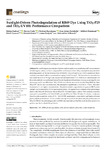Sunlight-Driven Photodegradation of RB49 Dye Using TiO2-P25 and TiO2-UV100: Performance Comparison

Use este enlace para citar
http://hdl.handle.net/2183/39998
Excepto si se señala otra cosa, la licencia del ítem se describe como Creative Commons Attribution (CC BY) license 4.0
Colecciones
- Investigación (FCIE) [1228]
Metadatos
Mostrar el registro completo del ítemTítulo
Sunlight-Driven Photodegradation of RB49 Dye Using TiO2-P25 and TiO2-UV100: Performance ComparisonAutor(es)
Fecha
2024Cita bibliográfica
Zaaboul, F.; Canle, M.; Haoufazane, C.; Santaballa, J.A.; Hammouti, B.; Azzaoui, K.; Jodeh, S.; Hadjadj, A.; El Hourch, A. Sunlight-Driven Photodegradation of RB49 Dye Using TiO2-P25 and TiO2-UV100: Performance Comparison. Coatings 2024, 14, 1270. https://doi.org/10.3390/ coatings14101270
Resumen
[Abstract] By combining measurements of photocatalysis under solar irradiation with measurements of total organic carbon, we have compared the performance of two TiO2-based photocatalysts in the photodegradation of the dye Reactive Blue 49 (RB49). TiO2-P25 and TiO2-UV100 commercial photocatalysts were tested within a concentration ranging from 0.5 to 4 g/L. The dye solution concentration was varied from 10 to 50 mg/L and its pH was increased from 3 to 9. Extensive characterization of the photocatalysts was performed using Fourier-transform infrared spectroscopy, scanning electron microscopy and X-ray diffraction. TiO2-UV100 proved to be more active in adsorbing RB49 dye than TiO2-P25. At low dye concentrations, the adsorption equilibrium is reached in 15 min. This time increases to 1 h at higher concentrations. The photocatalytic degradation of aqueous RB49 under sunlight was monitored by UV-Vis spectrophotometry. The apparent rate constant of dye photodegradation with TiO2-UV100 is twice that of TiO2-P25. The total organic carbon (TOC) analysis showed a removal of around 98% with TiO2-UV100 and only 85% with TiO2-P25 after 3 h of solar irradiation. Over five photocatalytic cycles of 3 h, TiO2-UV100 maintained a more stable and higher efficient photocatalytic performance. All our results converge toward a better photocatalytic performance of TiO2-UV100 for the photodegradation of RB49 dye and indicate that the most decisive factor is its greater capacity to adsorb the pollutant.
Palabras clave
TiO2
RB49
Photodegradation
Solar photocatalysis
Adsorption
Water treatment
RB49
Photodegradation
Solar photocatalysis
Adsorption
Water treatment
Versión del editor
Derechos
Creative Commons Attribution (CC BY) license 4.0






